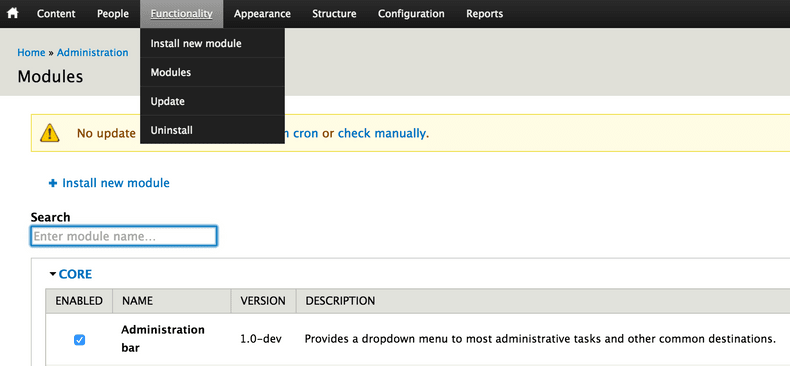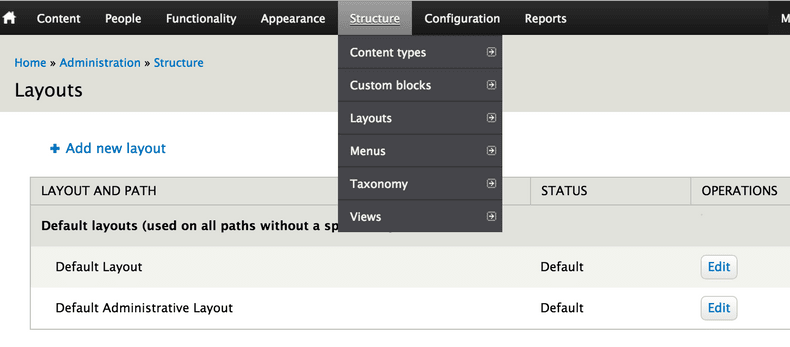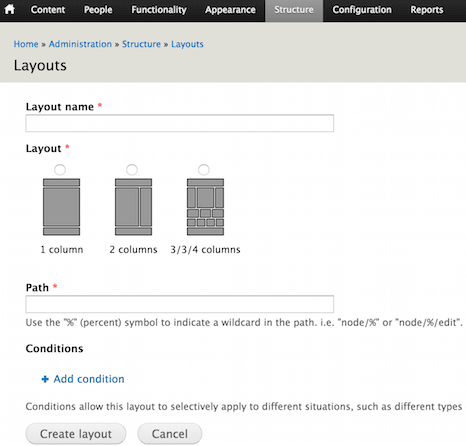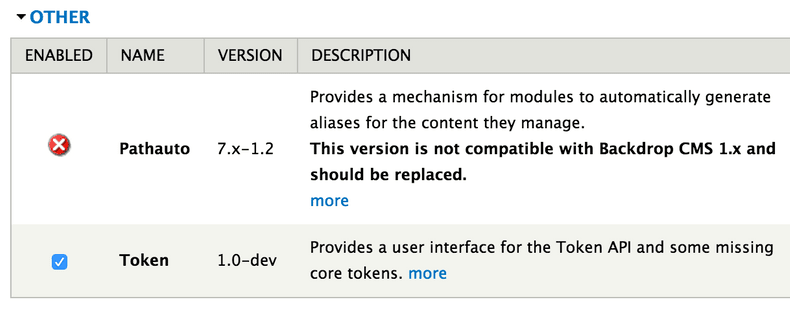Today I finally decided to install Backdrop CMS which is in version 1.0 preview and on Jan 15th, 2015 will see his first official release.
Here I will not compare it if is better or not than Drupal 7, I will just report the changes I saw and how complex I found the process to migrate a module from Drupal 7 to Backdrop
Installation
Looks the same as Drupal 8, check the following image and let me know if you’re not agree

File Structure
The files structure of Backdrop is so similar to Drupal 8 check in the following image.

Modules UI
The modules menu is named now Functionality and as you can see in the following image, the Backdrop CMS core implement a feature implemented by module module_filter in Drupal 7.

Layouts
In example.com/admin/structure/layouts you can find a new concept Layouts, Layouts is an implementation similar to Panels Layouts. By default, there are two layouts Admin and Default

You can create your own Layouts and apply this layout using a match by URL and/or you can add conditions, as you can see in the following image.

Backdrop doesn’t have a menu to get the list of block generated via code, this list of blocks is only available when editing a Layout and add a block as you can see in the following image.

Module Migration
Well, maybe this is the part every buddy was expecting, OK to test I decide to check the list of most used modules in Drupal from Usage project.
I decide to test with Token the #4 most used module in Drupal with 746,542 installations reported until Nov 15, 2014.
I skip ctools because off Ctools is too complex and views are already in Backdrop core :P
Enable modules in Backdrop
Structures of Modules in Backdrop is the same as Drupal 7, but we need to apply couple changes to avoid Backdrop report the module was invalid as you can see in the following image.

The only required change in file token.info is to replace core to backdrop. Check how token.info must look like the file to be processed by Backdrop
name = Token
description = Provides a user interface for the Token API and some
missing core tokens.
core = 7.x
files[] = token.test
version = "7.x-1.5"
project = "token"
backdrop = 1.xAfter that the installation process works like a charm, due to the hooks hook_requirements, hook_schema and hook_update_xx are supported.
Changes detected
As you can imagine there are some things must be changed, in order to use the new Backdrop functions.
Caveats I just replace the code reported as PHP Fatal error.
Replace function system_get_date_types
The function system_get_date_types does not exist in Backdrop, but after some reviews in the source code of core, I detect this function was replaced by system_get_date_formats.
Also in Drupal 7 this function return a multidimensional array, and each array entry has a title index, in backdrop this index was replaced by label
Replace cache_get and cache_set
These functions were replaced by function cache, this function receives a bin name and return a Cache class with methods set and get.
The default cache class in Backdrop is BackdropDatabaseCache
Let me show how a get change from Drupal 7
Drupal 7: cache_get('field:info', 'cache_token');
Backdrop: cache('token')->get('field:info');Now how a set change from Drupal 7 to Backdrop
Drupal 7: cache_set('field:info', $info, 'cache_token');
Backdrop: cache('token')->set('field:info', $info);Testing
After applying this changes in module token I need to test, I decided to create a script and try to execute with Drush, but I got the following error
Fatal error: Call to undefined function node_load() in
/Users/enzo/www/backdrop/token_test.php on line 8That is because Drush doesn’t know how to load the Backdrop bootstrap, so I decide to create a script with the bootstrap included as you can see in the following snippet.
<?php
define('BACKDROP_ROOT', getcwd());
require_once BACKDROP_ROOT . '/core/includes/bootstrap.inc';
backdrop_bootstrap(BACKDROP_BOOTSTRAP_FULL);
$node = node_load(1);
$nid = token_replace('[node:nid]', array('node' => $node));
print 'Node ID: ' . $nid . "\n";The previous script generates the following output.
Node ID: 1At least this simple transformation is working, I am not saying the migration process of a module to Backdrop is a piece of cake, but until now looks like is not a titanic project for sure any case is different.
You can check more details about migrate module to Backdrop in video Porting a Module to Backdrop - Basics.
If you want to test my version of Token to Backdrop check the project Backdrop Token
I hope you found this blog entry useful.